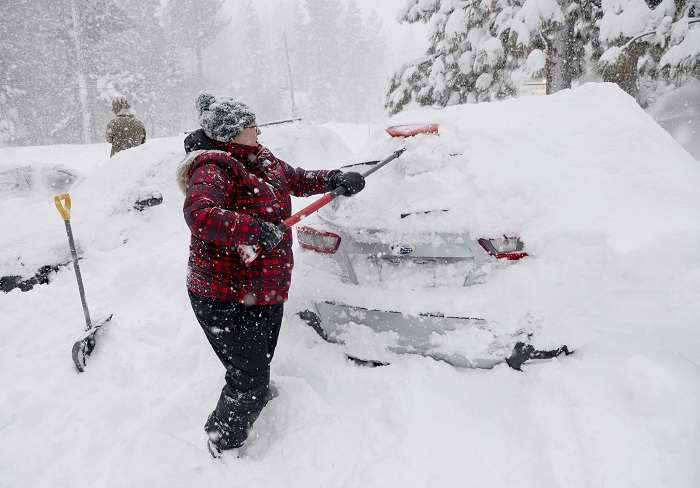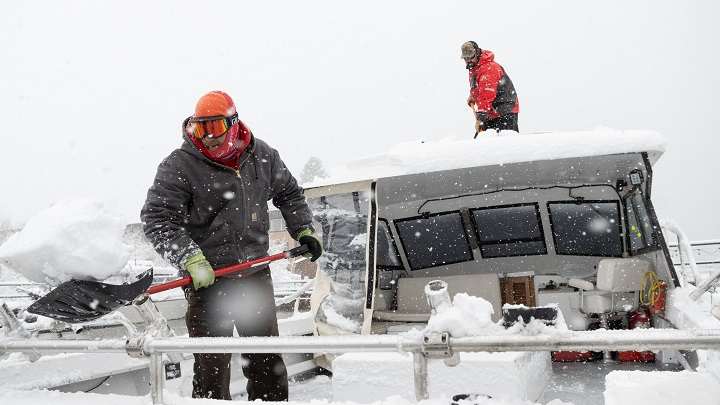In this article, we’ll cover the details of the upcoming blizzard, its potential impacts, and important safety tips for navigating through this intense weather event. Let’s dive into what to expect and how you can be prepared.
Understanding the Blizzard Warning

Blizzard warnings have been issued for the Sierra Nevada region starting Friday night and continuing through Sunday morning. The National Weather Service (NWS) has classified this storm as particularly dangerous, with heavy snow, strong winds, and near-zero visibility expected across much of the mountain range. A blizzard warning is the highest level of alert for winter weather, signaling that conditions are severe enough to pose a threat to life and property.
What Constitutes a Blizzard?
A blizzard is defined not just by snowfall but by a combination of factors, including:
- Sustained winds of 35 mph or greater
- Heavy snowfall or blowing snow reducing visibility to less than a quarter of a mile
- Storm duration of at least three hours
The Sierra Nevada storm is expected to meet all these criteria, making it a formidable event for anyone in the region.
Areas Under the Warning
The blizzard warning covers much of the Sierra Nevada, particularly at elevations above 6,000 feet. This includes popular destinations like Lake Tahoe, Yosemite National Park, and Mammoth Mountain. Lower elevations will see less snow but may still experience hazardous conditions, including icy roads and reduced visibility.
If you’re planning to travel through or near the Sierra Nevada, it’s critical to stay informed about road conditions and any potential closures, as this storm could disrupt travel throughout the region.
The Expected Impacts
Blizzards in the Sierra Nevada are not uncommon, but each storm brings its own set of challenges. With this particular storm, a combination of heavy snowfall, strong winds, and frigid temperatures could lead to a variety of impacts, both in terms of safety and logistics.
1. Heavy Snow Accumulation
The Sierra Nevada is expected to receive substantial snowfall over the course of the storm, with accumulations of up to 4 feet in some areas. Higher elevations could see even more, with totals possibly reaching 6 feet or more in localized spots. This will create hazardous conditions for anyone traveling through the region and could lead to:
- Road closures and delays
- The potential for avalanches in steep terrain
- Power outages due to the weight of snow on trees and power lines
2. Strong Winds
In addition to heavy snow, this storm will bring strong winds with gusts up to 60 mph or higher in exposed areas. These winds will exacerbate the effects of the snow, creating whiteout conditions that make travel nearly impossible. Blowing snow can obscure roadways, landmarks, and even nearby vehicles, leading to dangerous driving conditions.
For those in the mountains or other exposed areas, the wind chill will make temperatures feel significantly colder, posing a risk of hypothermia or frostbite for anyone caught outdoors without adequate protection.
3. Travel Disruptions
The blizzard is expected to have a significant impact on travel throughout the Sierra Nevada. Interstate 80, a major route through the region, is likely to see closures or severe delays due to snow accumulation and poor visibility. Other highways, including US 50 and CA-89, may also be affected, especially at higher elevations.
Air travel could also be disrupted, particularly at Reno-Tahoe International Airport, where flights may be delayed or canceled due to the storm. Travelers should check with their airlines and plan for potential delays.
4. Avalanche Risk
Heavy snowfall combined with strong winds can significantly increase the risk of avalanches in the Sierra Nevada. The combination of new snow on top of an unstable base layer can create dangerous conditions, especially in areas of steep terrain. The Eastern Sierra Avalanche Center has already issued warnings for the region, advising backcountry enthusiasts to stay informed about avalanche conditions and avoid risky areas.
Safety Tips During a Blizzard
While a blizzard can be a spectacular natural event, it also poses significant risks. Here are some important safety tips to keep in mind if you find yourself in the Sierra Nevada during the storm.
1. Avoid Non-Essential Travel
The most important rule during a blizzard is to stay off the roads unless absolutely necessary. Even well-equipped vehicles can struggle in heavy snow, and getting stuck or stranded in a storm can be dangerous. If you must travel, be sure to:
- Check the latest road conditions and closures through the California Department of Transportation (Caltrans) website or app.
- Equip your vehicle with chains or snow tires, and bring emergency supplies, including food, water, blankets, and a shovel.
- Let someone know your travel plans and estimated arrival time.
2. Stay Indoors
If you’re at home or in a cabin during the storm, the best course of action is to stay indoors and avoid venturing out. High winds and blowing snow can make it difficult to see even short distances, increasing the risk of getting lost or disoriented. Make sure you have enough supplies to last through the storm, including:
- Non-perishable food and water for several days
- Flashlights, batteries, and candles in case of power outages
- Warm clothing and blankets to stay comfortable if the heat goes out
3. Be Prepared for Power Outages
Heavy snow can bring down power lines, especially in rural or mountainous areas. If you live in a region prone to outages, make sure you have alternative sources of heat and light. Generators, propane heaters, and battery-powered lights can all be helpful, but be sure to use them safely and follow all manufacturer guidelines to avoid fire hazards or carbon monoxide poisoning.
4. Monitor Local Weather Updates
The weather can change quickly in the mountains, so it’s essential to stay informed throughout the storm. The National Weather Service provides regular updates on conditions, including snow totals, wind speeds, and any changes to the blizzard warning. You can check their website or tune in to local news stations for the latest information.
Apps like MyRadar or AccuWeather are also helpful for tracking the storm in real time, giving you a clearer picture of what to expect in your specific location.
5. Watch for Signs of Frostbite and Hypothermia
With temperatures expected to drop significantly during the storm, it’s important to watch for signs of frostbite or hypothermia if you do need to spend time outdoors. Frostbite can occur in as little as 30 minutes in extreme cold and typically affects exposed areas like the fingers, toes, and face. Symptoms include numbness, tingling, and discoloration of the skin.
Hypothermia is a more serious condition that occurs when your body loses heat faster than it can produce it. Symptoms include shivering, confusion, and slurred speech. If you or someone else is showing signs of hypothermia, seek medical help immediately.
Preparing for Post-Blizzard Recovery
Once the storm passes, the challenges don’t end. Cleaning up after a major blizzard can take time and requires caution. Here are some post-blizzard tips to keep in mind.
1. Clearing Snow Safely
Shoveling snow can be physically demanding, especially after a heavy storm like this. Take breaks frequently, use proper lifting techniques to avoid strain, and stay hydrated. If you have access to a snowblower, it can make the job easier, but be sure to follow all safety instructions to avoid injury.
2. Check on Neighbors
In remote or mountainous areas, neighbors may need help after a storm, especially if power or phone service is down. Check in on elderly or vulnerable neighbors to make sure they have what they need.
3. Beware of Black Ice
Even after the snow has stopped falling, roads and sidewalks may remain dangerous. Black ice, a thin layer of ice that’s nearly invisible, can form on surfaces and pose a significant risk for slips and falls. Drive slowly and cautiously, and be mindful when walking outdoors.
Related Post:
Mass Casualty Incident at the Mexico Border: A Comprehensive Overview
VNC Distribution Wholesale Disposable Pods Vape: The Ultimate Guide
Mega Millions 3/5/24: What You Need to Know About This Epic Jackpot Event
The blizzard warnings for the Sierra Nevada through Sunday morning are a reminder of the power and unpredictability of nature. While the storm will bring challenges, it also presents an opportunity to be prepared, stay safe, and experience the awe-inspiring beauty of a winter wonderland. By following safety guidelines and staying informed, you can weather the storm and enjoy the snow-covered peaks when calm returns.



